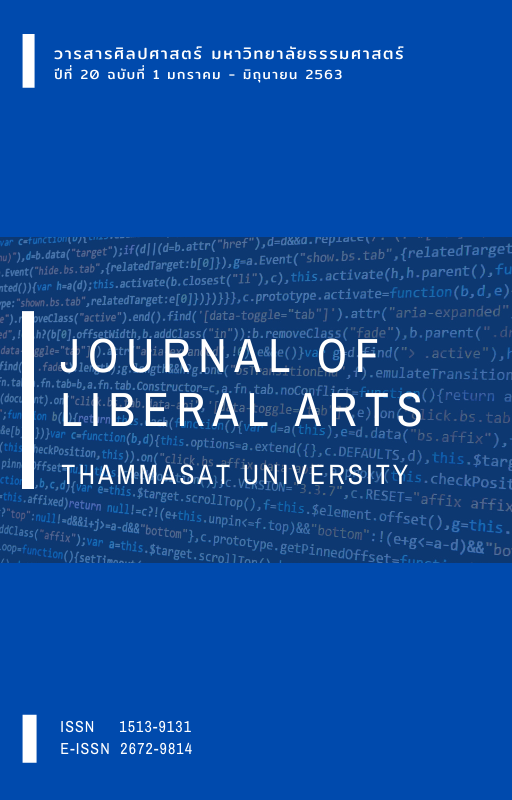วิกฤตนิวเคลียร์เกาหลีเหนือ: กรณีศึกษาการแก้ไขวิกฤต ภายใต้การทูตพหุภาคี
Main Article Content
บทคัดย่อ
การวิจัยนี้มีวัตถุประสงค์เพื่อศึกษา 1) การแก้ไขวิกฤตนิวเคลียร์เกาหลีเหนือ ภายใต้การเจรจาหกฝ่าย 2) สาเหตุที่ทำให้การเจรจาหกฝ่ายยังไม่บรรลุเป้าหมาย และ 3) เพื่อเสนอแนวทางการแก้ไขอุปสรรคในการเจรจาหกฝ่าย ผลการศึกษาพบว่าการเจรจาหกฝ่ายเป็นการเจรจาอสมมาตร เนื่องจากเกาหลีเหนือมีสถานะเป็นรัฐอ่อนแอ เมื่อเปรียบเทียบกับสหรัฐอเมริกาที่เป็นมหาอำนาจ อย่างไรก็ตาม เกาหลีเหนือสามารถใช้กลยุทธ์ในการต่อรองจนนำไปสู่ความตกลงด้านนิวเคลียร์ในปี ค.ศ. 2005 โดยสหรัฐอเมริกาให้หลักประกันด้านความมั่นคงและการยุติการคว่ำบาตร เพื่อแลกกับการที่เกาหลีเหนือยุติการพัฒนาอาวุธนิวเคลียร์ แต่ในขั้นตอนการปฏิบัติตามข้อตกลงกลับไม่สามารถหาข้อสรุปร่วมกันในประเด็นการตรวจสอบ เกาหลีเหนือและสหรัฐอเมริกาจึงได้กลับมาใช้กลยุทธ์กดดันแต่ละฝ่าย ยิ่งไปกว่านั้น ความไม่ไว้วางใจระหว่างเกาหลีเหนือกับสหรัฐอเมริกาและพันธมิตร ซึ่งก็คือญี่ปุ่นและเกาหลีใต้ ถือเป็นอุปสรรคสำคัญในการแก้ไขปัญหา ดังนั้น การดำเนินมาตรการสร้างความไว้วางใจระหว่างกันจึงเป็นแนวทางสำคัญในการแก้ไขอุปสรรคดังกล่าว
Downloads
Article Details
เอกสารอ้างอิง
วิเชียร อินทะสี. (2551). การดำเนินนโยบายการทูตแบบบีบบังคับของสหรัฐอเมริกาในกรณีความขัดแย้งกับเกาหลีเหนือในช่วงหลังสงครามเย็น (รายงานผลการวิจัย). ปทุมธานี: สถาบันเอเชียตะวันออกศึกษา มหาวิทยาลัยธรรมศาสตร์.
วิเชียร อินทะสี. (2553). การดำเนินนโยบายการทูตแบบบีบบังคับของสหรัฐอเมริกาในวิกฤตนิวเคลียร์เกาหลีเหนือ. วารสารสุโขทัยธรรมาธิราช, 23(2), 5-15.
วิเชียร อินทะสี. (2557). การดำเนินกลยุทธ์ขู่: ทางสองแพร่งของระบอบในเกาหลีเหนือ. ในวิเชียร อินทะสี และอรไท โสภารัตน์ (บรรณาธิการ). รัฐศาสตร์: สังคมศาสตร์ที่หลากหลาย (น. 64-83). พิษณุโลก: ดาวเงินการพิมพ์.
วิเชียร อินทะสี. (2559). มุมมองด้านความมั่นคงของเกาหลีใต้ อดีตและปัจจุบัน. วารสารเอเชียตะวันออกศึกษา, 20(2), 99-128.
Ahn, J. H. (2015, February 11). Rodong Sinmun blasts ‘bastard’ Lee Myung-bak over memoir. NK.News.ORG. Retrieved from https://www.nknews.org
Baldwin, D. A. (2016). Power and international relations: A conceptual approach. Princeton, NJ: Princeton University Press.
Burke, A., Lee-Koo, K., & McDonald, M. (2014). Ethics and global security: A cosmopolitan approach. London, England: Routledge.
Buszynski, L. (2009). Russia and North Korea: Dilemmas and interests. Asian Survey, 49(5), 809-830.
Debs, A., & Monteiro, N. P. (2017). Nuclear politics: The strategic causes of proliferation. New York, NY: Cambridge University Press.
Difillippo, A. (2012). US-Japan-North Korea security relations: Irrepressible interests. London, England: Routledge.
Gamble, A. (2010). The politics of deadlocks. In A. Narlikar (Ed.). Deadlocks in multilateral negotiations (pp. 25-46). New York, NY: Cambridge University Press.
George, A. L. (1991). Forceful persuasion: Coercive diplomacy as an alternative to war.
Washington, D.C.: United States Institute of Peace Press.
Habeeb, W. M. (1988). Power and tactics in international negotiation: How weak nations bargain with strong nations. Baltimore, MD: John Hopkins University Press.
Habeeb, W. M. (2002). US-Egyptian aid negotiations in the 1980s and 1990s. In W. I. Zartman & J. Z. Rubin (Eds.). Power and negotiation (pp. 81-105). Ann Arbor, MI: University of Michigan Press.
Han, Y. S. (2007). The six-party talks and security cooperation in Northeast Asia. In S. H. Joo & T. H. Kwak (Eds.). North Korea’s second nuclear crisis and Northeast Asian security (pp. 191-205). Burlington, VT: Ashgate Publishing Company.
Han, Y. S. (2010). An arms control approach to building a peace regime on the Korean peninsula: Evaluation and prospects. In T. H. Kwak & S. H. Joo (Eds.). Peace regime building on the Korean peninsula and Northeast Asian security cooperation (pp. 45-62). Surrey, England: Ashgate Publishing Limited.
Harrison, S. S. (2002). Korean endgame: A strategy for reunification and U.S. disengagement. Princeton, NJ: Princeton University Press.
Heo, U., & Woo, J. Y. (2008). The North Korean nuclear crisis: Motives, progress and prospects. Korea Observer, 39(4), 487-506.
Horowitz, S., & Ye, M. (2008a). Keeping instability at bay: China’s post-Deng leaders and the Korean crisis. Korea Observer, 39(4), 603-629.
Horowitz, S., & Ye, M. (2008b). China’s grand strategy, the Korean nuclear crisis and the six-party talks. Pacific Focus, 21(2), 45-97.
Joo, S. H. (2007). Russia and North Korea, 1992-2006: From distant allies to normal neighbors. Korea Observer, 38(1), 65-99.
Kay, S. (2015). Global security in the twenty-first century: The quest for power and the search for peace (3rd ed.). Lanham, MD: Rowman & Littlefield.
Kim, H. N. (2000). Foreign relations under the Kim Dae-jung government. In K. Oh (Ed.). Korea briefing 1997-1999: Challenges and change at the turn of the century (pp. 145-172). Armonk, NY: M. E. Sharpe.
Kim, H. N., & Hammersmith, J. L. (2008). Japanese-North Korean relations after the second Pyongyang summit of 2004. North Korean Review, 4(1), 74-90.
Kim, J. E., Park, M., & Starr, B. (2016, June 22). North Korea fires two missiles, South Korea says. CNN. Retrieved from https://edition.cnn.com/2016/06/21/asia/north-korea-missile/index.html
Kim, S. S. (2004). Northeast Asia in the local-regional-global nexus: Multiple challenges and contending explanations. In S. S. Kim (Ed.). The international relations of Northeast Asia (pp. 3-61). Lanham, MD: Rowman and Littlefield Publishers, Inc.
Kydd, A. H. (2005). Trust and mistrust in international relations. Princeton, NJ: Princeton University Press.
Lebow, R. N. (1981). Between peace and war: The nature of international crisis. Baltimore, MD: John Hopkins University Press.
Mack, A. (1975). Why big nations lose small wars: The politics of asymmetric conflict. World Politics, 27(2), 175-200.
Mack, A. (1993). The nuclear crisis on the Korean peninsula. Asian Survey, 33(4), 339-352.
Mearsheimer, J. J. (2001). The tragedy of great power politics. New York, NY: W. W. Norton & Company.
Pollack, J. D. (2011). No exit: North Korea, nuclear weapons and international security. London, England: The International Institute for Strategic Studies.
Sagan, S. D. (2000). Rethinking the causes of nuclear proliferation: Three models in search of a bomb. In V. C. Utgoff (Ed.). The coming crisis: Nuclear proliferation, U.S. interests and world order (pp. 17-50). Cambridge, MA: The MIT Press.
Sigal, L. V. (2001). North Korea on hold again. Bulletin of the Atomic Scientists, 57(3), 32-39.
Smith, H. (2015). North Korea: Markets and military rule. Cambridge, England: Cambridge University Press.
Snyder, S. (2011). Envisioning a Northeast security framework: The Korean peninsula. In B. Seliger & W. Pasha (Eds.). Towards a Northeast Asian security community: Implications for Korea’s growth and economic development (pp. 27-38). New York, NY: Springer.
Starkey, B., Boyer, M. A., & Wilkenfeld, J. (2015). International negotiation in a complex world. Lanham, MD: Rowman and Littlefield Publishers, Inc.
Sutter, R. G. (2013). China’s approach to North Korea: Seeking stability and influence amid changing circumstances and conflicting imperatives. In A. T. H. Tan (Ed.). East and South-East Asia: International relations and security perspectives (pp. 56-65). London, England: Routledge.
U.S. Department of State. (2005). Joint statement of the fourth round of the six-party talks, Beijing, September 19, 2005. Retrieved from https://www.state.gov/p/eap/regional/c15455.htm
Walker, R. A. (2004). Multilateral conference: Purposeful international negotiation. New York, NY: Palgrave Macmillan.
Waltz, K. N. (1979). The theory of international politics. Reading, MA: Addison-Wesley Publishing Company.
Wang, Y. (2005). China’s role in dealing with the North Korean nuclear issue. Korea Observer, 36(3), 465-488.
Weissmann, M. (2012). The East Asian peace: Conflict prevention and information peacebuilding. New York, NY: Palgrave Macmillan.


